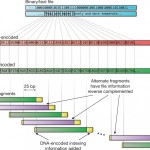 The general approach to storing a binary file as DNA, described in detail below. Goldman et al., Nature It’s easy to get excited about the idea of encoding information in single molecules, which seems to be the ultimate end of the miniaturization that has been driving the electronics industry. But it’s also easy to forget that we’ve been beaten there—by a few billion years. The chemical information present in biomolecules was critical to the origin of life and probably dates back to whatever interesting chemical reactions preceded it. It’s only within the past few decades, however, that humans have learned to speak DNA. Even then, it took a while to develop the technology needed to synthesize and determine the sequence of large populations of molecules. But we’re there now, and people have started experimenting with putting binary data in biological form. Now, a new study has confirmed the flexibility of the approach by encoding everything from an MP3 to the decoding algorithm into fragments of DNA. The cost analysis done by the authors suggest that the technology may soon be suitable for decade-scale storage, provided current trends continue. Trinary encoding Computer data is in binary, while each location in a DNA molecule can hold any one of four bases (A, T, C, and G). Rather than using all that extra information capacity, however, the authors used it to avoid a technical problem. Stretches of a single type of base (say, TTTTT) are often not sequenced properly by current techniques—in fact, this was the biggest source of errors in the previous DNA data storage effort. So for this new encoding, they used one of the bases to break up long runs of any of the other three. Read 9 remaining paragraphs | Comments
The general approach to storing a binary file as DNA, described in detail below. Goldman et al., Nature It’s easy to get excited about the idea of encoding information in single molecules, which seems to be the ultimate end of the miniaturization that has been driving the electronics industry. But it’s also easy to forget that we’ve been beaten there—by a few billion years. The chemical information present in biomolecules was critical to the origin of life and probably dates back to whatever interesting chemical reactions preceded it. It’s only within the past few decades, however, that humans have learned to speak DNA. Even then, it took a while to develop the technology needed to synthesize and determine the sequence of large populations of molecules. But we’re there now, and people have started experimenting with putting binary data in biological form. Now, a new study has confirmed the flexibility of the approach by encoding everything from an MP3 to the decoding algorithm into fragments of DNA. The cost analysis done by the authors suggest that the technology may soon be suitable for decade-scale storage, provided current trends continue. Trinary encoding Computer data is in binary, while each location in a DNA molecule can hold any one of four bases (A, T, C, and G). Rather than using all that extra information capacity, however, the authors used it to avoid a technical problem. Stretches of a single type of base (say, TTTTT) are often not sequenced properly by current techniques—in fact, this was the biggest source of errors in the previous DNA data storage effort. So for this new encoding, they used one of the bases to break up long runs of any of the other three. Read 9 remaining paragraphs | Comments
Continued here:
MP3 files written as DNA with storage density of 2.2 petabytes per gram






